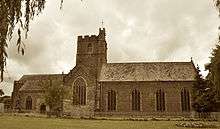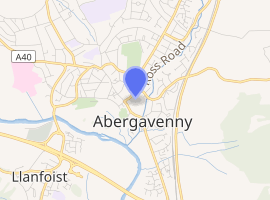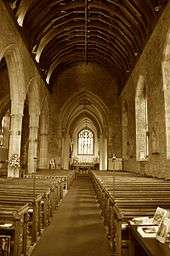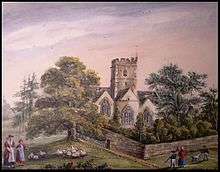Priory Church of St Mary, Abergavenny
The Priory Church of St Mary, Abergavenny is a parish church in the centre of Abergavenny in Monmouthshire, Wales.
| Priory Church of St Mary | |
|---|---|
 Priory Church of St Mary | |

| |
| 51.8214°N 3.0154°W | |
| Location | Abergavenny, Monmouthshire |
| Country | Wales |
| Denomination | Church in Wales |
| Website | http://www.stmarys-priory.org/ |
| History | |
| Status | Parish church |
| Founder(s) | Hamelin de Ballon |
| Architecture | |
| Functional status | Active |
| Heritage designation | Grade I |
| Designated | 11 July 1952 |
| Administration | |
| Deanery | Abergavenny |
| Diocese | Monmouthshire |
| Clergy | |
| Canon(s) | Revd Canon Mark Soady Sub Prior Revd Tom Bates |
St. Mary's has been called "the Westminster Abbey of Wales" because of its large size,[1] and the numerous high status tomb monuments and medieval effigies surviving within it.[2] The church was designated as a Grade I listed building on 1 July 1952.[3]
History

It was originally the church of the Benedictine Priory, established under Hamelin de Balun the first Norman holder of the title Lord Abergavenny, which in the 1090s became Baron Bergavenny. At this time it was a cell of the Abbey of Saint Vincent at Le Mans in France. Recent archaeological surveys have revealed significant finds of Roman Samian ware pottery, suggesting that the church may have been built on the site of a previous place of Romano-British and possibly Celtic worship.
Henry de Abergavenny was a prior here and later at Llandaff in the late 12th century and was chosen to assist at the coronation of King John I of England in 1199. Successive Lords of Abergavenny were by necessity also benefactors, including William de Braose, 4th Lord of Bramber.
In 1320 John Hastings, 2nd Baron Hastings, called on the Pope to set up an investigation into the Priory, in which the monks were accused of failing to maintain the Benedictine Rule. The prior, Fulk Gaston, absconded to the mother Abbey with the church silver.
By the time of the Dissolution of the Monasteries the Priory had only the prior and four monks. Due to the close connections between the Lords of Abergavenny and the Tudor dynasty the priory was spared and became the parish church.[4]
Description

The church is cruciform in layout and impressively large with a chancel and nave 172 feet (52 m) in length. The central tower has ten bells.
The church is mainly in the Decorated and Perpendicular Period architectural styles and was, like many churches, subjected to Victorian period refurbishment in the 19th century, with sadly little trace of the original Norman architecture surviving. The Norman baptismal font was rediscovered in the churchyard in the 19th century; it had been removed from the church in the 17th century by a local Baptist minister, John Abbot, on the grounds that he did not believe in infant baptism.
The oaken choir stalls with carved misericords and carved lattice work backs, however, are 15th-century survivals. They bear the name of the prior at that time Wynchestre and his own stall remains, slightly raised and surmounted by a mitre.
Effigies
The chief claim to fame for the church today lies in its collection of effigies. The effigies are in wood, alabaster and marble and range in date from the 13th century to the 17th century. One effigy is that of John de Hastings, Lord of Abergavenny (died 1324) and shows him as a young knight, wearing a long surcoat over a hauberk and a hood of fine chainmail.
Lewis Chapel or Joseph Chapel
The chapel is named after Dr David Lewis, first Principal of Jesus College, Oxford, whose tomb it contains. In the chapel are two female effigies. One holds a heart in her palm, a device used to signify a possible heart burial, and dates from the end of the 13th century: she is believed to be Eva de Braose and (unusually for a female effigy) bears a shield bearing the Cantilupe arms.[5] Her neighbour, a second female effigy, dates from the 14th century, and is said to be a member of the Hastings family who died while pursuing her pet red squirrel when it escaped and ran along the castle walls at Abergavenny Castle, causing her to fall to her death.[5] The effigy has a light chain around her waist which was documented as having once been attached to a small squirrel which formed part of the effigy. It has since been knocked off or defaced, perhaps during the Commonwealth or Protectorate period (1649–1660). The Chapel was dedicated to St Jopseh the spouse of the BVM by Bishop Richard Pain in November 2017
Herbert or Benedict Chapel

The Herbert Chapel contains recumbent monuments and effigies, in both alabaster and marble, associated with the ap Thomas and Herbert families. These include Sir Richard Herbert of Coldbrook, executed with his elder brother William, Earl of Pembroke after the Battle of Edgecote in 1469 and William's illegitimate son Richard Herbert of Ewyas. The latter was brought up with Pembroke's ward Henry Tudor, later Henry VII, and fought on his side at Bosworth in 1485.[6]
Within the chapel are also monumental brasses dating from the 16th and 17th centuries.
In 2018 the chapel was dedicated to St Benedict whose rule the Priory monks followed.
Burials in the Priory
- Edward Neville, 3rd Baron Bergavenny
- William ap Thomas and his 2nd wife Gwladys ferch Dafydd Gam
- John Hastings, 2nd Baron Hastings
- Laurence Hastings, 1st Earl of Pembroke
- Richard Herbert of Coldbrook and his wife Margaret Verch Thomas (sister of Sir Rhys ap Thomas)
- Sir Richard Herbert (died 1510)
The Jesse
The Jesse is an elaborate, very large, 15th-century wooden carving which would have once been part of an even larger carving forming a Jesse Tree telling the lineage of Jesus Christ based on that in the Bible.[7] It is unique in Britain and described by Tate Britain as one of the finest medieval sculptures in the world. In 2016 a new stained-glass Jesse window designed by Helen Whittaker was installed in the Lewis Chapel, incorporating the wooden Jesse at its foot.[8][9][10] The project was visited in April 2016 by the Archbishop of York, the Most Revd John Sentamu;[11] and the completed work was dedicated in the presence of Charles, Prince of Wales, on 7 July 2016.[12] The Jesse effigy was placed on a newly designed plinth in position below the Jesse Window in 2017.
Organ
Around 1830 a secondhand organ, built by John Byfield in 1760 for the Lord Mayor's Chapel in Bristol,[13] was sold to Mr. H. Smith and moved to the church. It stood in the gallery of the church, but was moved down when the church was being restored. It had two and a half manuals, the half being the swell organ.[14] The restoration committee decided not to sell the old instrument but to have it enlarged, and in 1883, they contracted with Conacher and Co who enlarged it to three manuals and 27 speaking stops. It was re-opened on 21 February 1884, the festivities including a recital by the newly appointed organist, Throne Biggs, late deputy organist of Lichfield Cathedral.[15] A specification of the organ can be found on the National Pipe Organ Register.[16] It was moved from its original position in the north aisle to the north chancel around 1910.
The organ was rebuilt again in 1981 by E. A. Cawston but around 1998 it began to sink into the floor of the church and was dismantled and removed. The full cost of restoration is preventing its return, and an electronic instrument is currently in use.
A small 5 stop pipe organ from St Nicholas' Church, Durham has been in use since 2015. The pipes from the old organ have been fitted into this instrument.
Organists
- Edward Howells, 1830[17]–1855
- Francis Marshall Ward, 1855–1857[18] (afterwards organist of St Mary’s Church, Lincoln).
- Ernest Thomas Bennett Gilbert, 1857[19]–1859 (formerly organist of St Paul’s Church, Newport)
- Jonathan Macrone, 1859–1860 (formerly organist of St Mary's Church, Cardiff)
- Mr. Crown, 1860–1861
- Jonathan Macrone, 1861 (reappointed)
- Mr. Doorly, 1861–????
- Charles Isaac Howells ???? - 1883[20]
- Thomas Throne Crick Biggs, 1883[21]–1894
- William Robert Carr, 1894–1933
- J.E. Hughes 1933-????
- Graham Elliott
- Tim Pratt, 1994–current
Bells
When the parishioners took ownership of the church around 1536-39, they bought the existing four bells, weighing a total of 45.5 long hundredweight (2,310 kg). Three bells were re-cast in the 17th and early 18th centuries. The tenor in 1603 and the 3rd in 1666, by Purdues of Bristol, and the treble in 1706 by Abraham Rudall. The bells were augmented to five in 1835 and then to six in 1845 by Jeffries & Price of Bristol.
To commemorate the Golden Jubilee of Queen Victoria in 1887, the bells were rehung and augmented to eight by Llewellins & James of Bristol.[22] The tenor of 19 long hundredweight (970 kg) was recast by Llewellins & James in 1893.
All the bells were recast in 1947 by John Taylor & Co of Loughborough and the ring augmented to 10 bells.[23] The new tenor now weighs 25 long hundredweight (1,300 kg).
The Church today
The restored Tithe Barn within the precincts of the Priory, was opened by HRH Charles, Prince of Wales on 23 October 2008 and houses the large 24 feet (7.3 m) tapestry depicting the history of Abergavenny and embroidered by volunteers to mark the 2000 Millennium. It is now the Priory's Heritage Centre and offers interpretative information open to the public and visitors.
After 18 years as vicar canon, Jeremy Winston was appointed Dean of Monmouth. Fr Mark Soady, former Chaplain at the University of Wales, Newport was collated as vicar on the Feast of the Epiphany 2012. Fr Mark was made Prior in September 2014 and installed as a Canon of Newport Cathedral in November 2014.Fr Mark left the Priory in March 2020.
After a nearly five hundred-year gap a new Monastic Community – the Holywell Community – was established on 2 September 2014.[24]
Gallery
 The tower
The tower West front
West front From the North
From the North Tower detail
Tower detail
References
| Wikimedia Commons has media related to Priory Church of St Mary, Abergavenny. |
- "St. Mary's Priory Church, Abergavenny (C) Jeremy Bolwell :: Geograph Britain and Ireland". Geograph.org.uk. 1 March 2008. Retrieved 18 April 2016.
- Bolwell, Jeremy. "The tomb of Sir Richard Herbert of Ewyas... (C) Jeremy Bolwell :: Geograph Britain and Ireland". Retrieved 5 January 2015.
- Good Stuff IT Services. "Church of St Mary - Abergavenny - Monmouthshire - Wales". British Listed Buildings. Retrieved 5 January 2015.
- Davies, Brian E. (2013). Wales: A Walk Through Time Flat Holm to Brecon. Amberley Publishing Limited. pp. Chapter 9. ISBN 9781445626178.
- "Historic Monuments". St Mary's Priory. Abergavenny. Retrieved 13 January 2016.
- "St Mary's Priory". St Mary's. Retrieved 6 December 2019.
- Bolwell, Jeremy. "The Jesse in St. Mary's Priory Church,... (C) Jeremy Bolwell :: Geograph Britain and Ireland". Retrieved 5 January 2015.
- "Plans for memorial window take step forward". Abergavenny Chronicle. 5 April 2013.
- "The Jesse Window explained". St Mary's Priory, Abergavenny. 16 June 2016. Retrieved 9 September 2016.
- Crampin, Martin (23 June 2016). "The Jesse Window explained". Stained glass from Welsh churches. Retrieved 9 September 2016.
- "St Mary's Priory, Abergavenny". Stmarysprioryabergavenny.wordpress.com. Retrieved 18 April 2016.
- "The Jesse Window is dedicated in the presence of the Prince of Wales". St Mary's Priory, Abergavenny. 8 July 2016. Retrieved 9 September 2016.
- Boeringer, James; Library, Royal College of Organists (Great Britain) (3 June 1989). "Organa Britannica: Organs in Great Britain 1660-1860 : a Complete Edition of the Sperling Notebooks and Drawings in the Library of the Royal College of Organists". Bucknell University Press. Retrieved 3 June 2017 – via Google Books.
- "Re-opening of the organ at St Mary's Abergavenny". Western Mail. England. 22 February 1884. Retrieved 29 May 2017 – via British Newspaper Archive.
- "Abergavenny. Reopening of the organ". South Wales Daily News. Wales. 22 February 1884. Retrieved 29 May 2017 – via British Newspaper Archive.
- "NPOR N09812". National Pipe Organ Register. British Institute of Organ Studies. Retrieved 29 May 2017.
- "Abergavenny". Monmouthshire Merlin. Wales. 10 July 1830. Retrieved 29 May 2017 – via British Newspaper Archive.
- Humphreys, Margaret; Evans, Robert (1997). Dictionary of Composers for the Church in Great Britain and Ireland. A&C Black. p. 350. ISBN 9780720123302.
- "Abergavenny. Appointment of Organist". Monmouthshire Beacon. Wales. 24 January 1857. Retrieved 29 May 2017 – via British Newspaper Archive.
- "The Proposed Testimonial to Mr. Howells". Abergavenny Chronicle. Wales. 7 September 1883. Retrieved 2 July 2020 – via British Newspaper Archive.
- "Success of a Lichfield Organist". Lichfield Mercury. England. 23 November 1883. Retrieved 29 May 2017 – via British Newspaper Archive.
- "Abergavenny. St Mary's Church". South Wales Daily News. Wales. 11 April 1887. Retrieved 30 May 2017 – via British Newspaper Archive.
- "Abergavenny, Monmths, S Mary". Dove's Guide for Church Bell Ringers. Dovemaster. 7 June 2012. Retrieved 29 May 2017.
- "ST MARY'S PARISH CHURCH HOLYWELL COMMUNITY: St Mary's Priory, Abergavenny". Stmarys-priory.org. 2 September 2014. Retrieved 18 April 2016.
Further reading
- Blair, Claude (1994). "The wooden knight at Abergavenny". Church Monuments. 9: 33–52.
- Lindley, Phillip (2006). "Two fourteenth-century tomb monuments at Abergavenny and the mournful end of the Hastings Earls of Pembroke". In Kenyon, John R.; Williams, Diane M. (eds.). Cardiff: architecture and archaeology in the medieval diocese of Llandaff. British Archaeological Association, Conference Transactions. 29. Leeds: Maney. pp. 136–60. ISBN 9781904350804.
- Lindley, Phillip; Galvin, Carol (2006). "New paradigms for the aristocratic funerary monument around 1300: reconstructing the tomb of John, second Baron Hastings (1287–1325) at Abergavenny Priory, Monmouthshire". Church Monuments. 21: 58–93.
- Lindley, Phillip (2007). "A Restoration restoration? The Herbert monuments at Abergavenny". Tomb Destruction and Scholarship: medieval monuments in early modern England. Donington: Shaun Tyas. pp. 199–236. ISBN 9781900289870.
- Morgan, Octavius (1872). Some Account of the Ancient Monuments in the Priory Church, Abergavenny. Newport.
- Nash, George, ed. (2015). An Anatomy of a Priory Church: the archaeology, history and conservation of St Mary’s Priory Church, Abergavenny. Oxford: Archaeopress. ISBN 978-1-78491-108-9.
- Tracy, Charles; Harrison, Hugh; Miles, Daniel (2002). "The choir-stalls at the Priory Church of St. Mary, Abergavenny". Journal of the British Archaeological Association. 155: 203–54.
- Winston, Jeremy (2000). St Mary's Priory Church, Abergavenny. Much Wenlock: R. J. L. Smith. ISBN 1872665381.